Jun 19 – Tue
We left the wonderful city of Annapolis at about 7:30am, an hour early due to the threat of mid-day rain. Upon leaving, we crossed under the famed “Annapolis Bay Bridge”.

We are gettin’ north pretty quick now, we just arrived at Baltimore Maryland, at a marina called The Marine Center at the Inner Harbor.
Our initial reactions after only 1 afternoon/night has been wow, nice city (as Jim Price would say “nice area”).
Like Detroit, Baltimore has received a lot of negative press.
But their downtown, sports complex area, inner harbor, and an area called Fells Point – are all wonderful areas of the city.
We started our afternoon with a walk around the Inner Harbor Marina Area.
It is a beautiful area with wonderful views across the harbor from the marina, especially at night.
One can see ; High Rise Hotels, Restaurants (Hard Rock), the Baltimore Aquarium, Historic Ships, a tented bandshell area with concerts at night, and Camden Yards ballpark is only 2 blocks away.
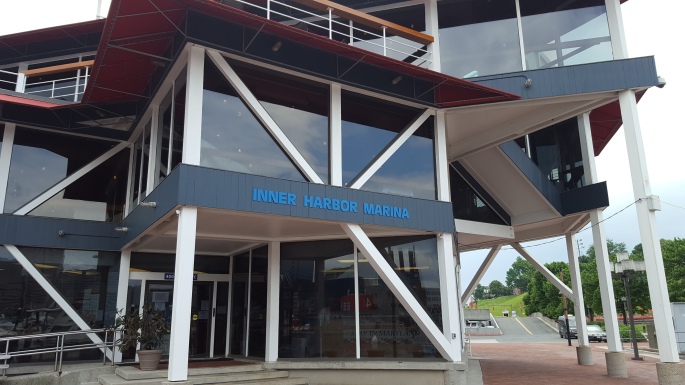

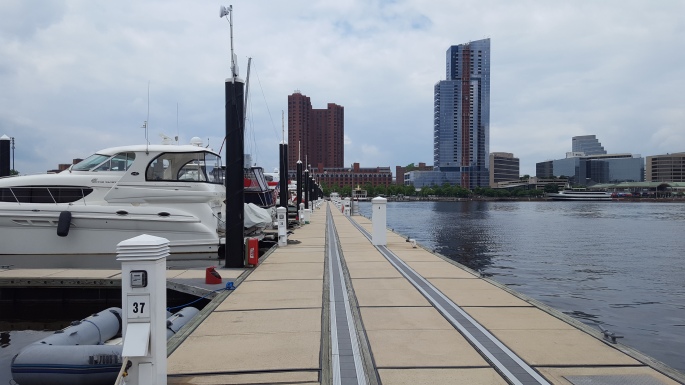
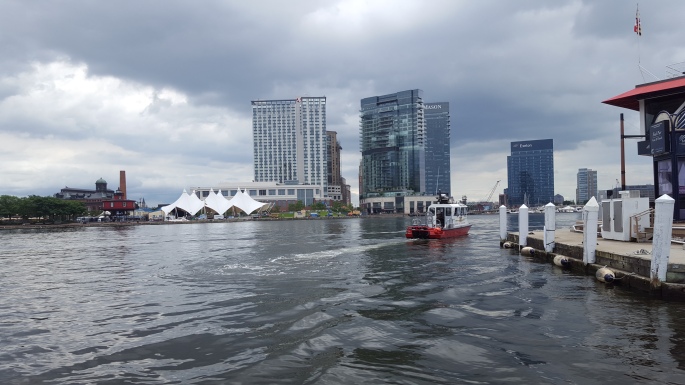

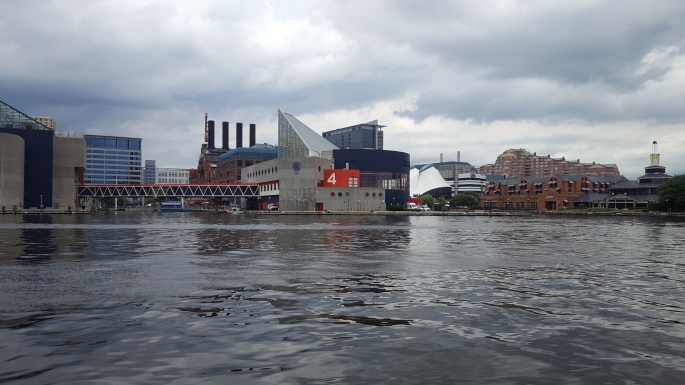
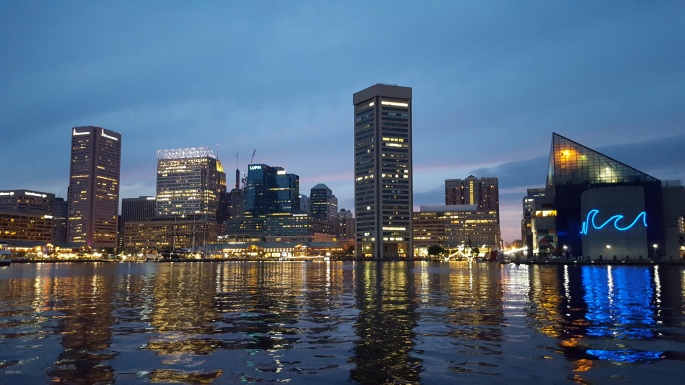
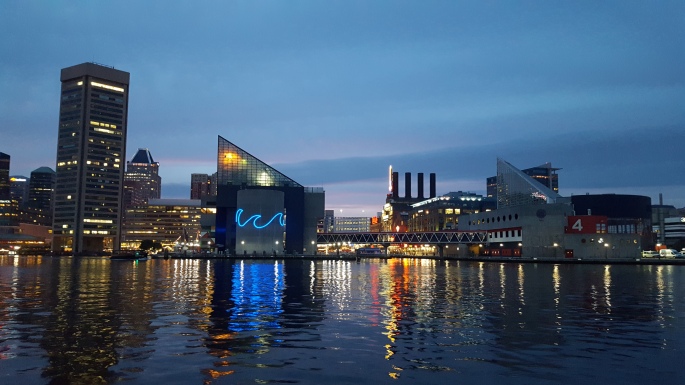
Even though there is a lot of stuff close to the marina, we unloaded the bikes because we would be in Baltimore for 3 days & also wanted to see an area further away called “Fells Point”.
The weather was threatening for rain, so we started our tour of the city indoors at a place called The Visionary Art Museum.
The museum specializes in the display of outsider art (aka “intuitive art,” “raw art,” or “art brut”), and has a lot of very large art, art made of many media & moving/mechanical art.
The city agreed to give the museum a piece of land on the south shore of the Inner Harbor under the condition that its organizers would clean up residual pollution from a copper paint factory and a whiskey warehouse that formerly occupied the site. It has been designated by Congress as America’s National Museum for Self-Taught Art.
It contains 67,000 ft2 of exhibition space and a permanent collection of approximately 4,000 pieces, with a lot of large pieces, as well as over 40 pieces from the Mechanical Theatre of London. 

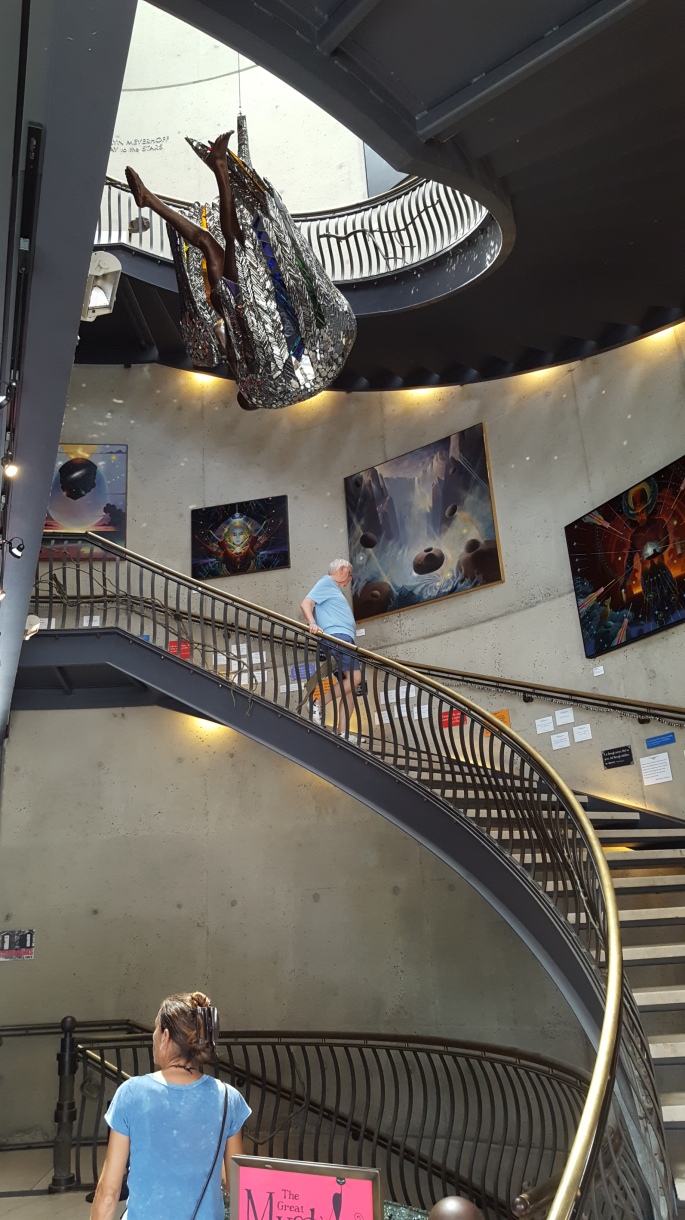
The museum was Cool, Strange, Weird, Interesting, Eclectic, etc.
Some of the most interesting stuff we saw was ;
> A tin-can man riding a bike, made of coffee cans.
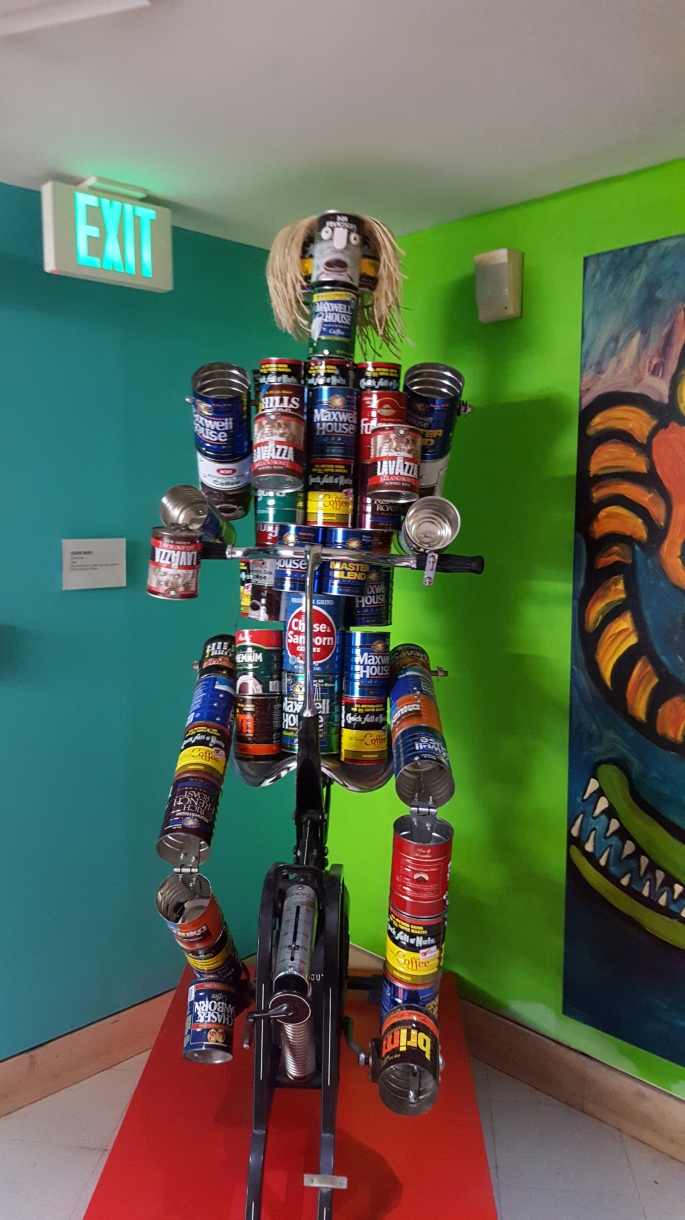
> A man made of marshmallows & peep marshmallows.
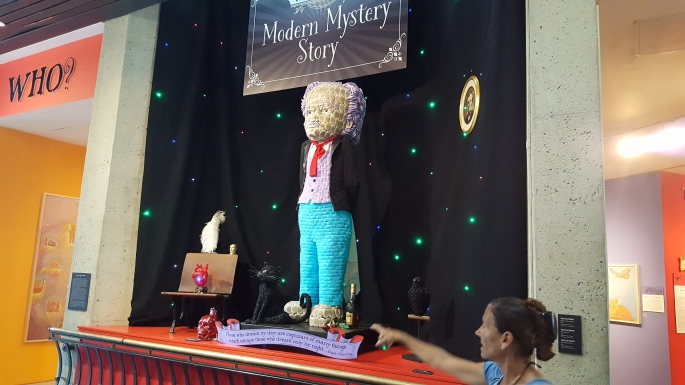
> A woman made of sea shells, beads, pearls, and exhaust vent tubing.
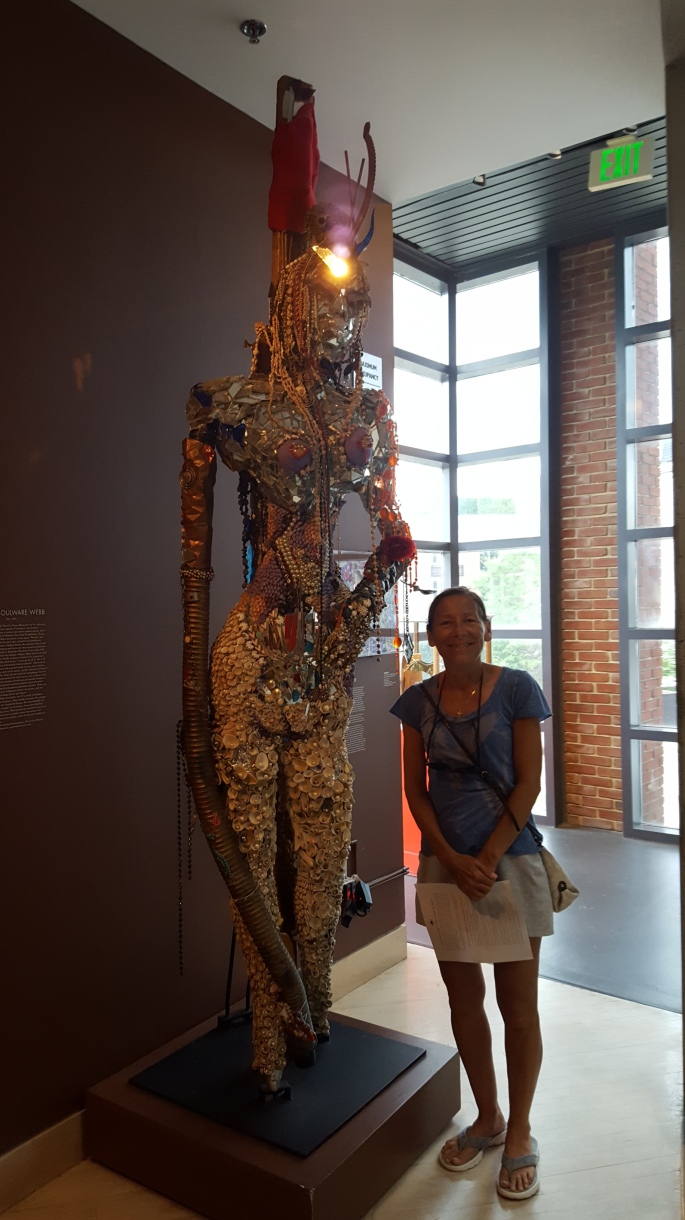
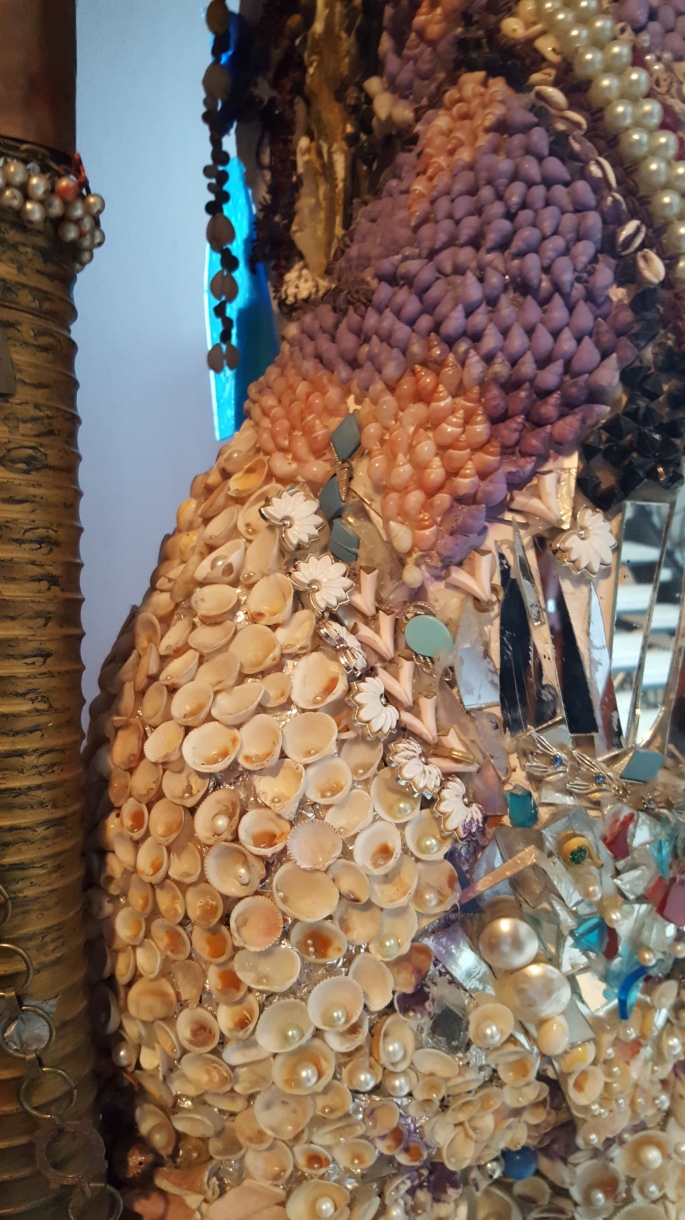
> A man made of colored wiring.
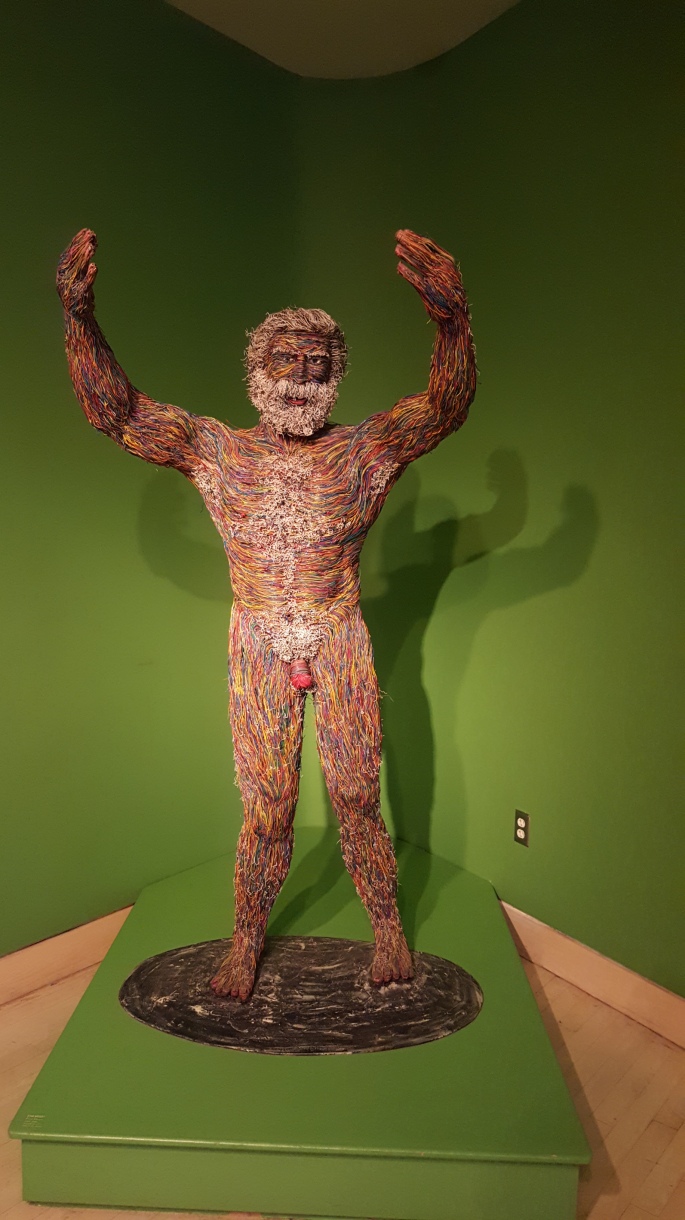
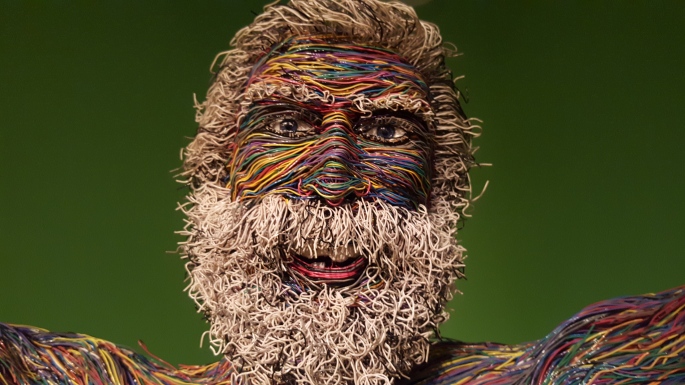
> A fallen Angel spinning from the ceiling.
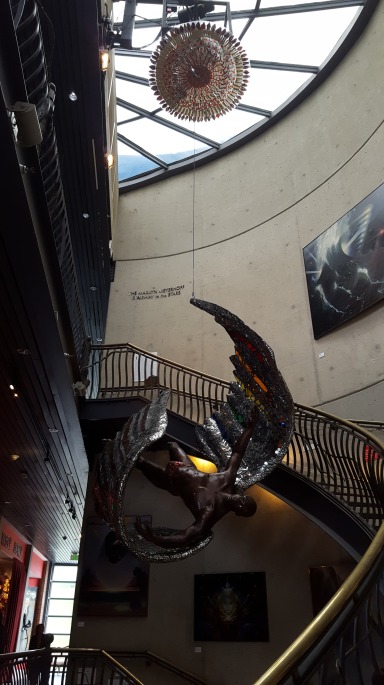
> An 1800 lb Ball of Bra’s (Dennis Taylor, do you have your boat deposit tray ready ? ).


> There were also several pieces of large human driveable art, being prepared for an upcoming Race in May of 2019 (Wilson’s & Palmer’s – time to break out your elephant & limber up them legs ?).


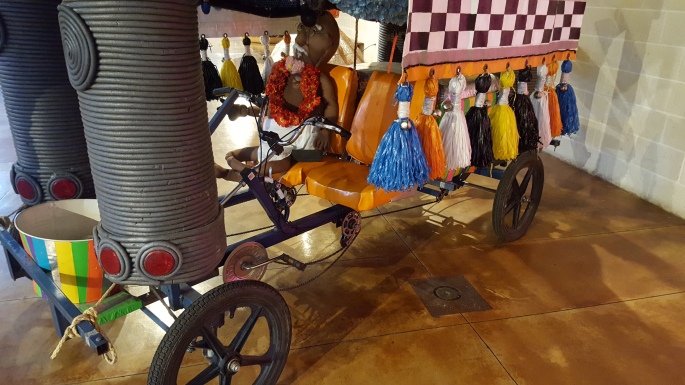
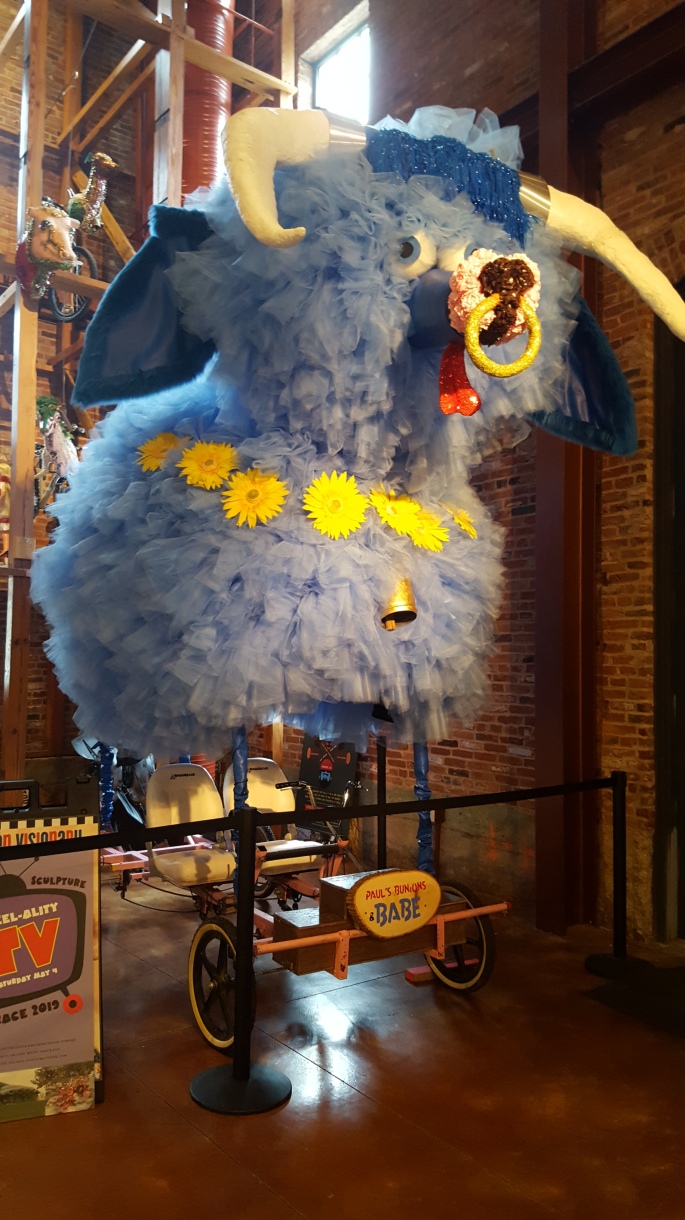
> The museum also had a cool movie/video called – “The Art of Flying” , by Jan Van Ijken. The Art of Flying is about the mysterious and mesmerizing flights of the Common Starling, and shows the constantly evolving patterns of the dense swarm of thousands of birds make while in flight in the Netherlands. The sound of so many birds is also overwhelming to the senses.
“The Art of Flying” , by Jan Van Ijken = https://youtu.be/GZ-bXw0pM_4
Maybe the coolest thing for me, was the exhibit on loan from the Mechanical Theatre of London. It featured many little pieces of art which all had electro-mechanically controlled motion = https://youtu.be/CHgyfKBY8qY
After the Art Museum, the weather was still dicey, so we went to the Aquarium, but the $45 price tag was a little steep for the few hours we had to visit.
It started to rain, so we ducked into Dick’s Last Resort, as our last resort to stay dry.
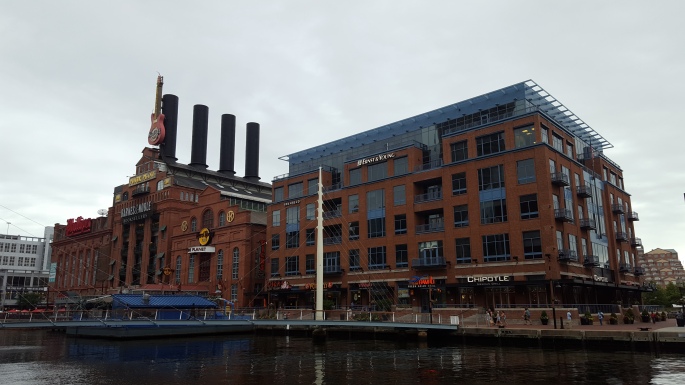
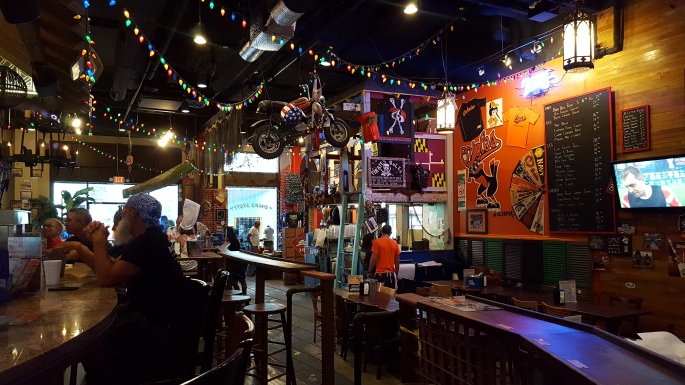
We had a drink and the rain let up after about 20 minutes.
After Dick’s, we headed out to an area we discovered on Google, called Fells Point.
Fell’s Point is a historic waterfront neighborhood established around 1763 and is located along the north shore of the Baltimore Harbor and the Northwest Branch of the Patapsco River. The area features many shops, antique stores, restaurants, coffee bars, music stores, a municipal market house with individual stalls, and over 120 pubs – the greatest concentration of drinking establishments and restaurants in the city.
> I looked up the directions to Fells point on google
> It looked like a more direct route to follow one main drag directly to Fells Point North, then work our way down to Fells Point South.
> Mistake – Fells point North took us thru The Projects !
> We started heading further south, back toward the waterfront, and got better directions from some locals.
> Once we arrived at Fells Point South, is was as advertised, really cool.



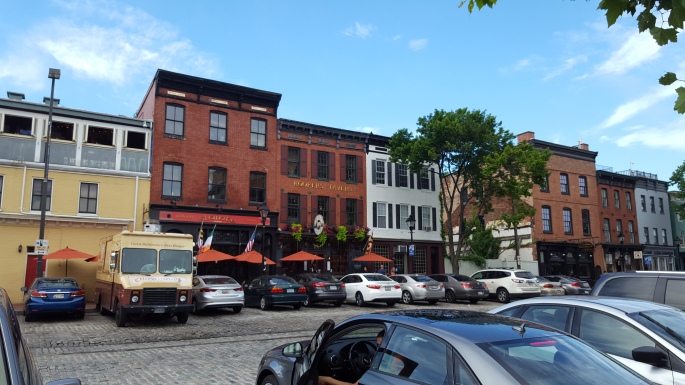
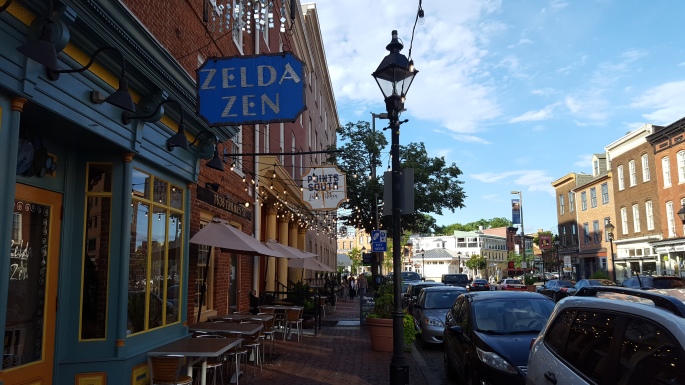
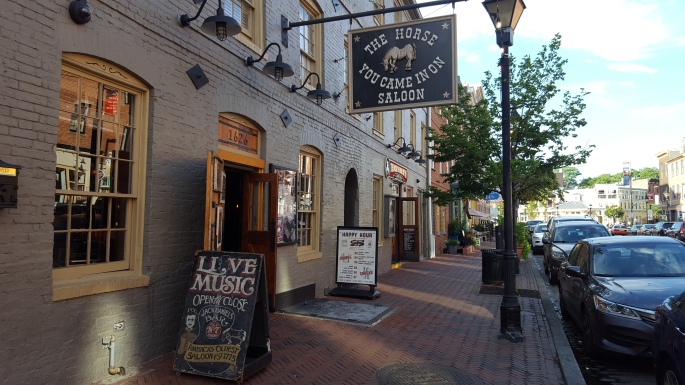


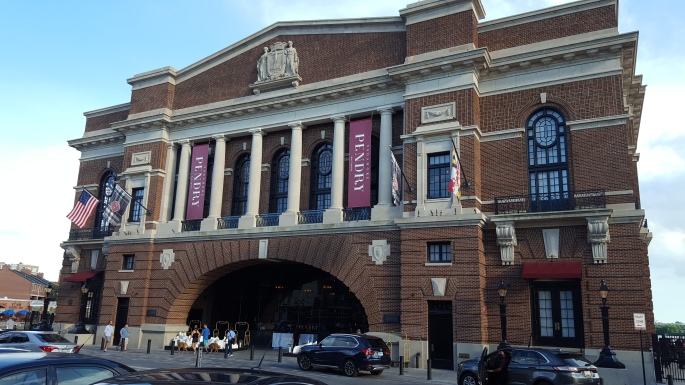
We had dinner at Fells Point, at a great waterfront place called Barcocina.
We shared some EXCELLENT Steak Tacos & Shrimp Quesadilla.
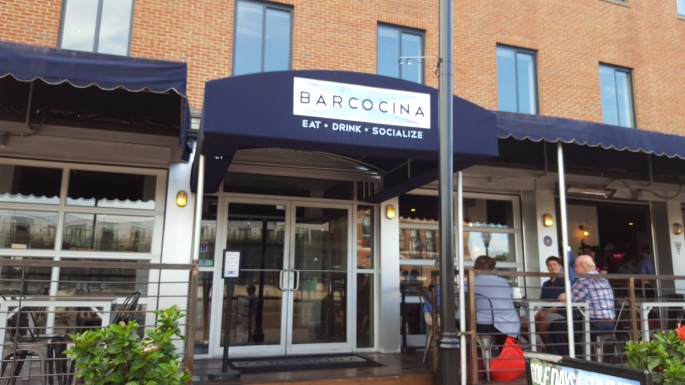

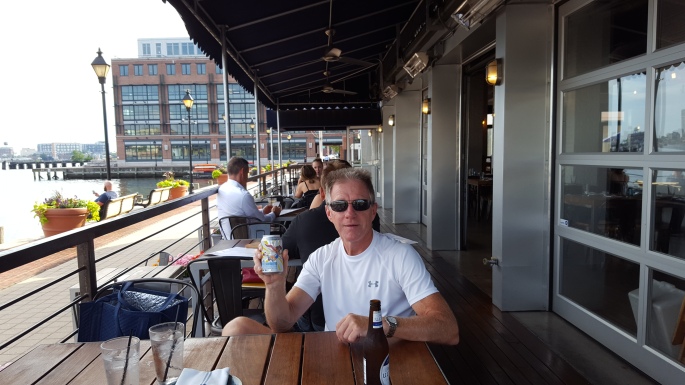
On the bike ride home, we listened to the music on the river front, watched some large volleyball tournament, & took some photos at the 7 Foot Knoll Lighthouse.
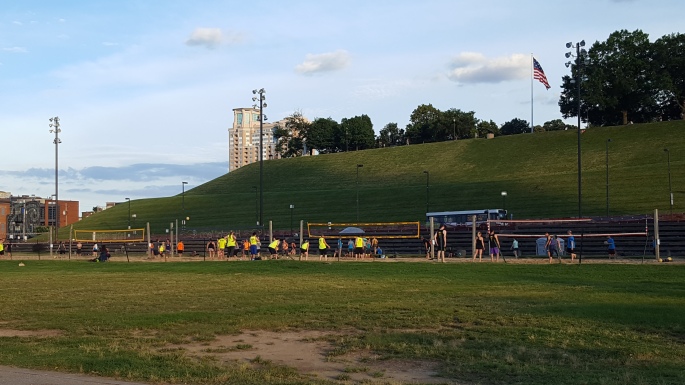

The Seven Foot Knoll Lighthouse was built in 1855 and is the oldest screw pile lighthouse in Maryland. A beacon of the Chesapeake Bay, it used to be located at the mouth of the Patapsco River, atop the Seven Foot Knoll in the Chesapeake Bay until it was replaced by a modern navigational aid and relocated to Baltimore’s Inner Harbor as a museum exhibit.
It was a very long afternoon & evening.
We were bike ride bushed.
That’s all for today.
Jun 20 – Wed
Wednesday was a great fun day, dedicated to Sports !
We started the day with a tour at Camden Yards Baseball Park.

Let’s start with some Camden Yards History, from our tour guide Bob.
> Camden Yards Ball Park is built on the former land & warehouse of the B&O Railroad.
> B&O stands for Baltimore & Ohio, Baltimore was the endpoint hub.
> Trains would arrive with a lot of freight that would be stored in the warehouse at Camden Yards.
> The Camden Yards Warehouse became the centerpiece of the Park, much like J.L Hudson Warehouse became the centerpiece for Ford Field.
> The Camden Yards Warehouse is 1100 feet long, and currently houses shops, offices, and management for The Orioles Ball Club.
> The ball park is connected to the warehouse via a very large, very long walkway.

Now let’s start with some history of The Baltimore Orioles.
When I was a 10 year old boy, I began following baseball as the Tigers won the World Series in 1968. I remember many great battles between Baltimore & Detroit from the early 70’s.
Some facts between what I remember & history from tour guide Bob.
> Baltimore has won the World Series 3 times (1966, 1970, 1983)
> Baltimore is 1 of only 2 teams to have four 20 game winners in the same season (1971).
> Baltimore has retired the numbers of 6 people
* Earl Weaver (4) – Managed the Orioles his entire career for 17 years.
* Frank Robinson (20) – MVP in both American & National Leagues & 2 Triple Crowns.
* Jim Palmer (22) – Won 3 Cy Young Awards & won 20 games in 8 straight seasons.
* Brooks Robinson (5) – 16 consecutive gold gloves,
* Eddie Murray (33) – 1 of 5 players to have both 3,000 career hits and 500 home runs.
* Cal Ripken (8) – 19 time All Star, 2 MVPs, & the Ironman 2632 consecutive games.
All of the retired players are honored at multiple places at the Park.
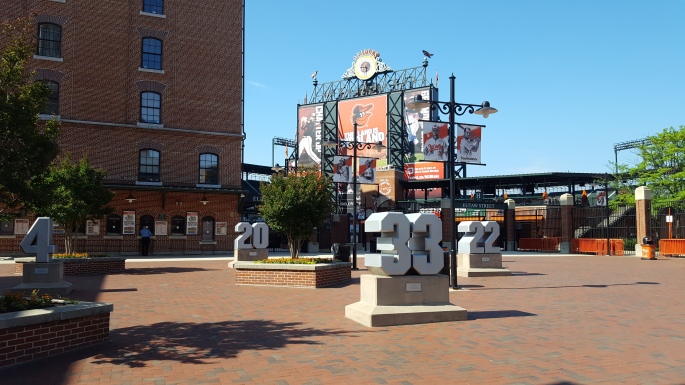
Bob took us all over the park.
We had a very intimate 4 person tour.
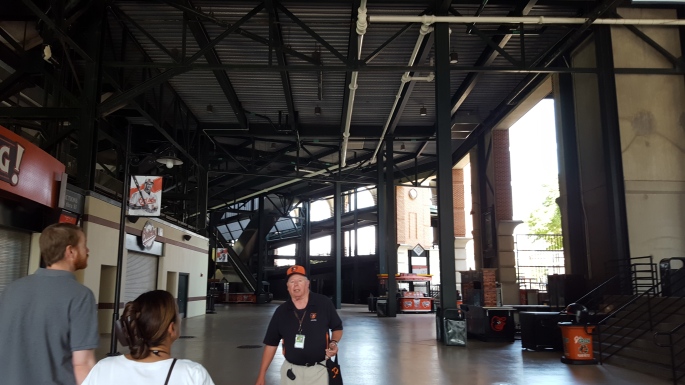
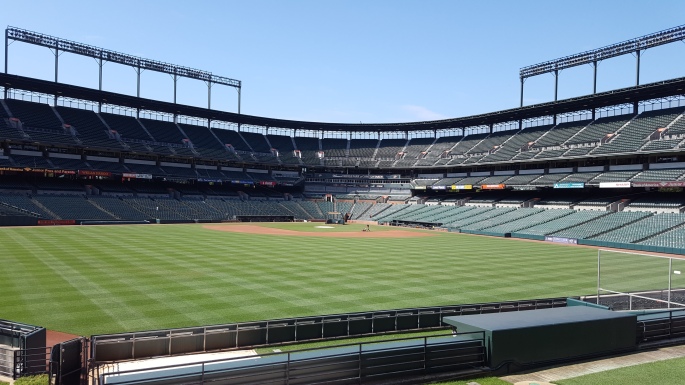

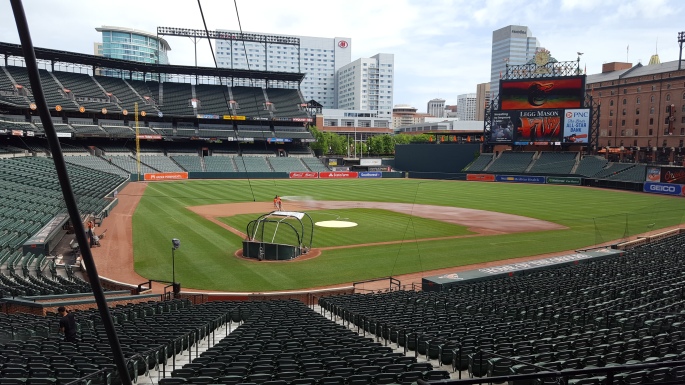
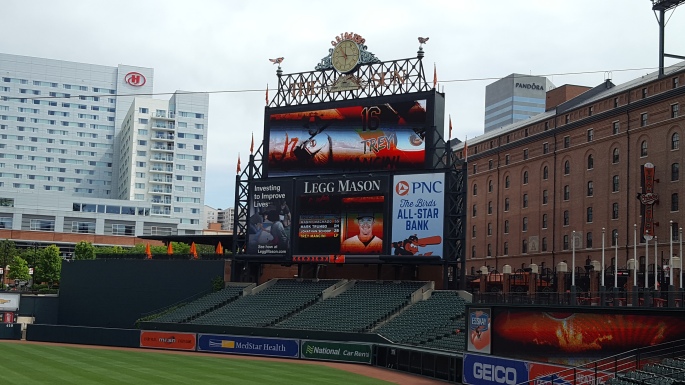

Some of the most cool places on the tour were the following ;
> The Control Room for all the stuff that goes on during the game & scoreboard.
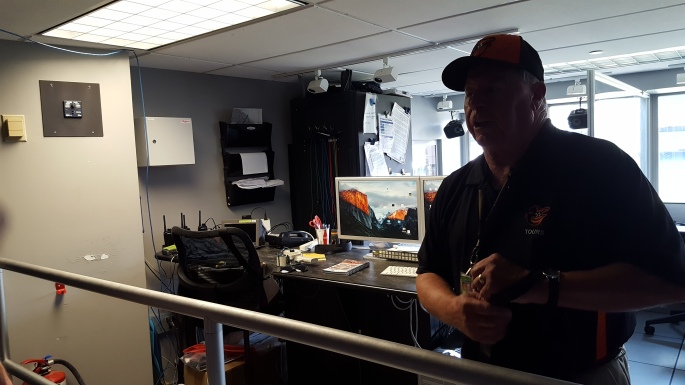
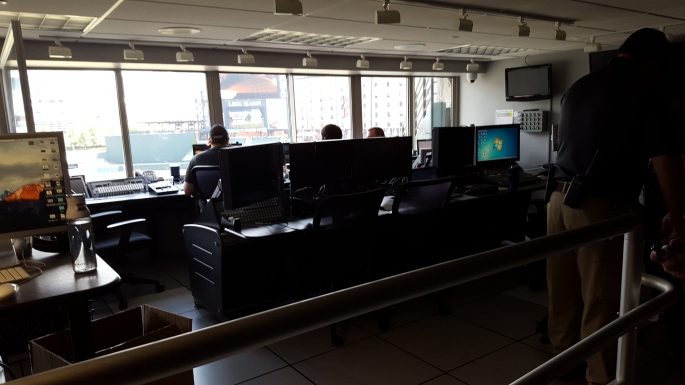
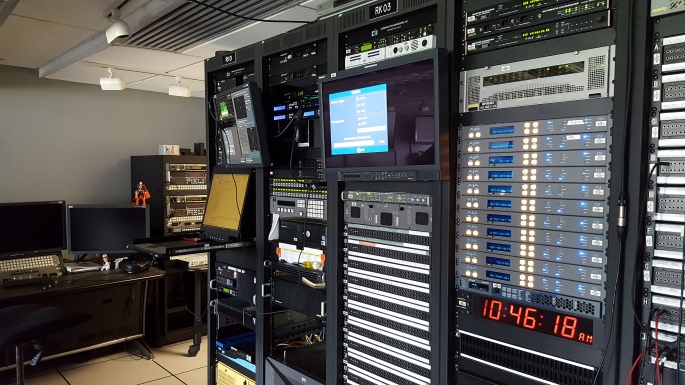
> The Press Boxes
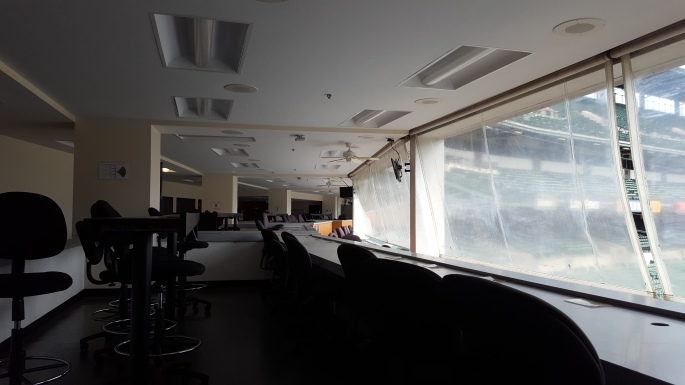
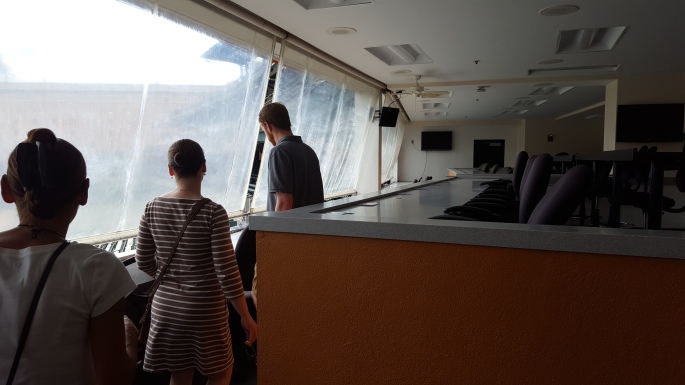
> The Cal Ripken Hub – showing the record 2131 consecutive games.
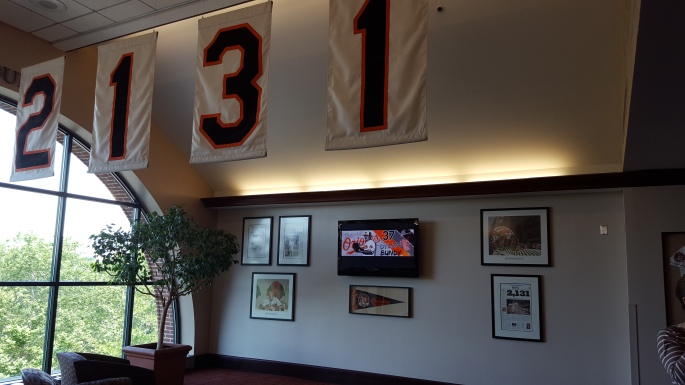
> Bob pointed out the St. Mary’s Industrial School for Boys, where Babe Ruth was raised as a young boy (gray church like building with peaks – more coming later).
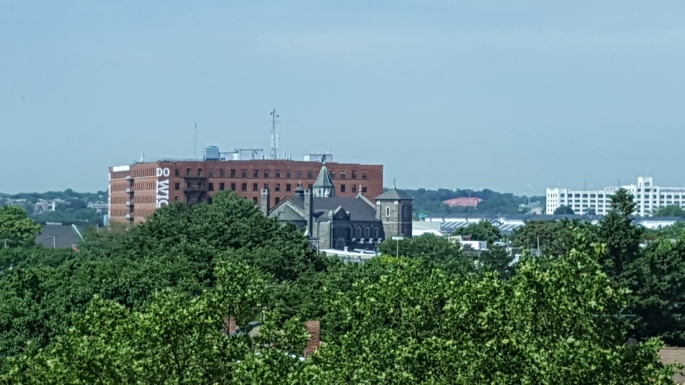
>The Orioles Trophy Case

> One of the most interesting bits of trivia Bob gave us was – that there has been 98 balls hit out of the park onto the walkway between the park & the Camden Yards Warehouse. Each historic home run is marked with a plaque of who hit the homer, the date, and the distance. Look at all the round dots on the pavement below. The warehouse itself has only been hit once by Darryl Strawberry during an All-Star Game Home Run Contest.

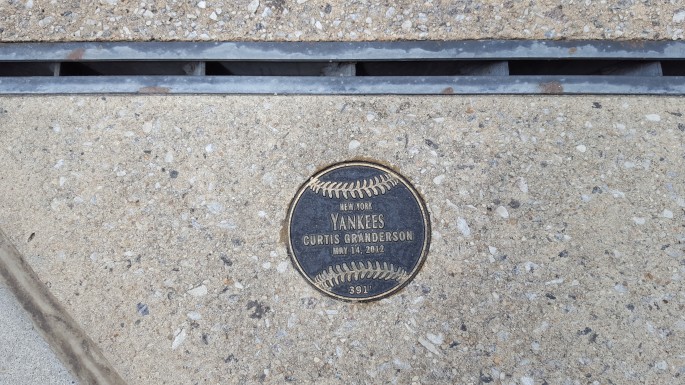
The tour of Oriole Park at Camden Yards was over, but the Baseball History was not.
Next stop was the Birthplace of Babe Ruth !
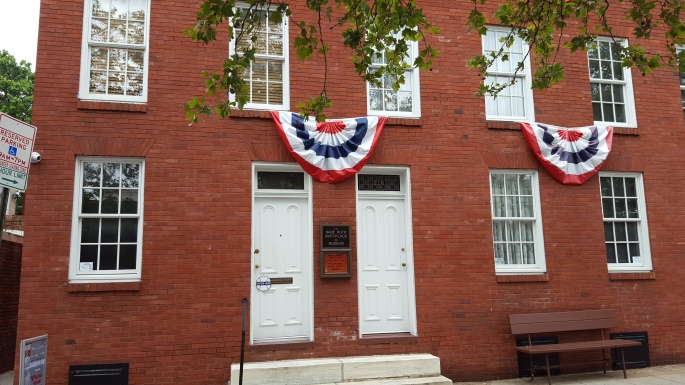
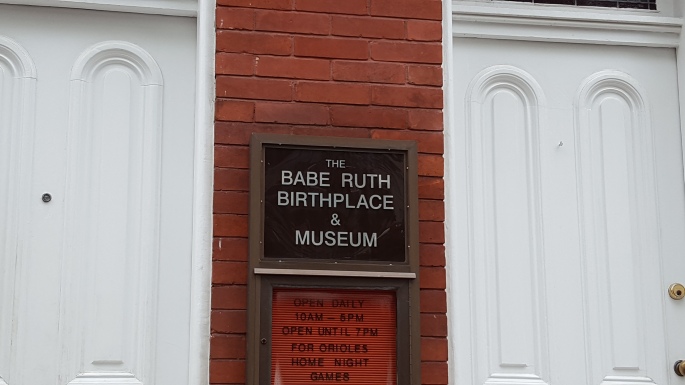
Rain was threatening, and we were on bikes, so we hustled thru the museum in about only 30 minutes.
Some of the coolest stuff we saw was ;
> The Bed that Babe Ruth was born in.
Babe Ruth was born George Herman Ruth Jr. on February 6, 1895, in Baltimore, Maryland. Ruth was raised in a poor waterfront neighborhood in Baltimore, where his parents, Kate Schamberger-Ruth and George Herman Ruth Sr, owned a tavern and lived above the bar. The bed below that Babe Ruth was born in, is actually at the home of Kate’s father, because the room above the bar was viewed as not clean enough to have a baby. Ruth was one of eight children born to the couple, and one of only two that survived infancy.
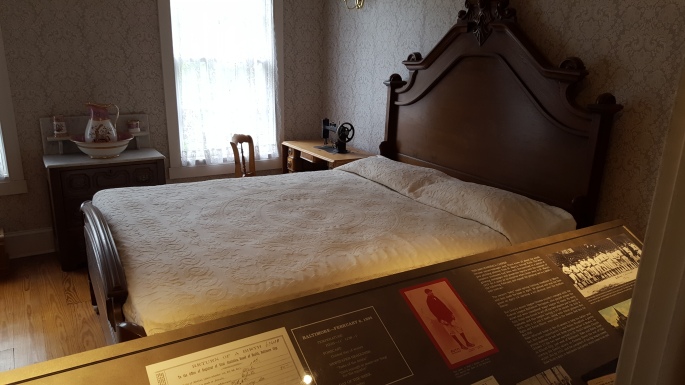
The story on the Babe’s childhood goes – At the age of 7, the trouble-making Ruth became too much of a handful for his busy parents. Routinely caught wandering the dockyards, drinking, chewing tobacco and taunting local police officers, his parents finally decided he needed more discipline than they could give him. Ruth’s family sent him to St. Mary’s Industrial School for Boys, a Catholic orphanage and reformatory that became Ruth’s home for the next 12 years. Ruth particularly looked up to a monk named Brother Matthias, who became a father figure to the young boy.
Remember the photo from Camden Yards – shown again below with the gray steeples.
As The Babe grew up and excelled at baseball, The Orioles Manager & Owner Jack Dunn had heard about The Babe. In 1913 Jack Dunn signed Babe Ruth, at the age of 19, to a $600 contract.
Initially , the monk Brother Matthias who had responsibility of Babe Ruth until age 21 had resisted allowing the contract to happen.
Jack Dunn then adopted George Herman Ruth.
As his career began, the players on Jack Dunn’s team teased George Herman Ruth, calling him Jack’s Baby, which went on to become his famous nickname.
But as time went on and Babe Ruth was becoming a well known minor league pitcher, Jack Dunn’s team was loosing money and he was forced to sell his top players including The Babe. On July 9th, 1913 Jack Dunn sold Babe Ruth, Ben Egan, and Ernie Shore to the Boston Red Sox for $25,000
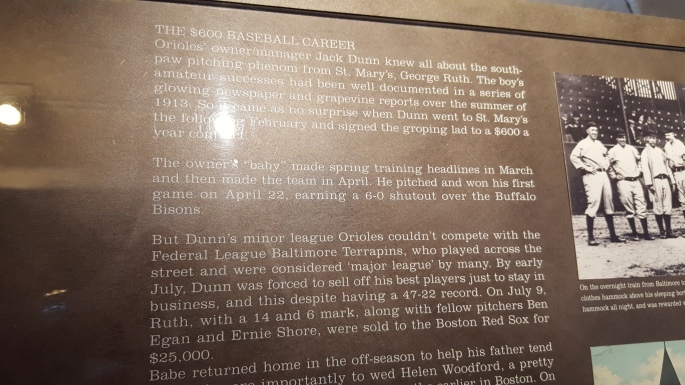
Maybe the coolest thing we saw at the museum was a baseball bat given to Babe Ruth by Shoeless Joe Jackson (bottom bat of the two below).
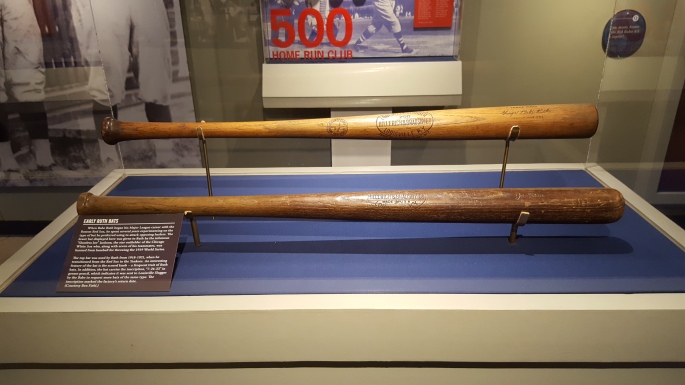
George Herman (Babe Ruth) – with Family !
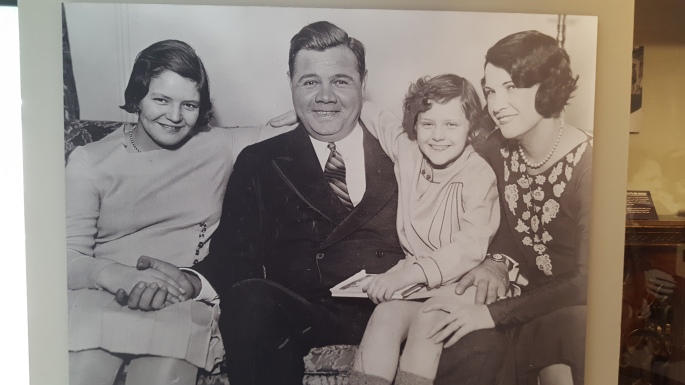
A lot of Sports today, eh ?
But wait, there’s more !
We spent early Wednesday night at the Baltimore Raven’s Practice Facility !
I’m not sure if you remember the Charleston blog of May 11th, but we had met with my financial advisor Randy Eschels & family.
We met his daughter Erin Eschels on May 11th.
We learned that Erin works for The Baltimore Ravens in the Video Production Department.
Erin offered a tour, & we graciously accepted.
Erin advised that – Photos were only allowed in certain areas.
There are no photos of anything directly involving the players, locker room, or even the practice field.
The practice facility appeared to be a joint venture between The Ravens & Under Armour.
It was beautiful, all adorned in Raven Purple.
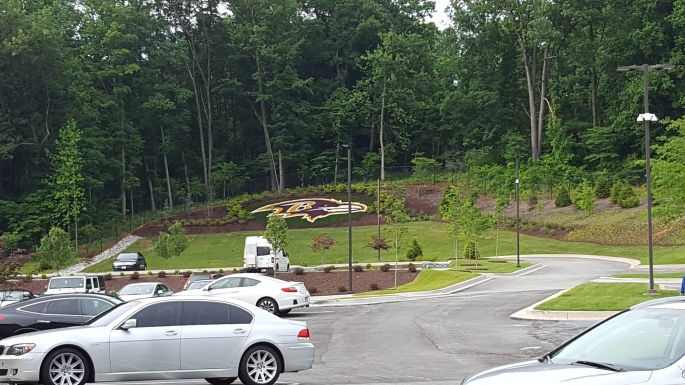
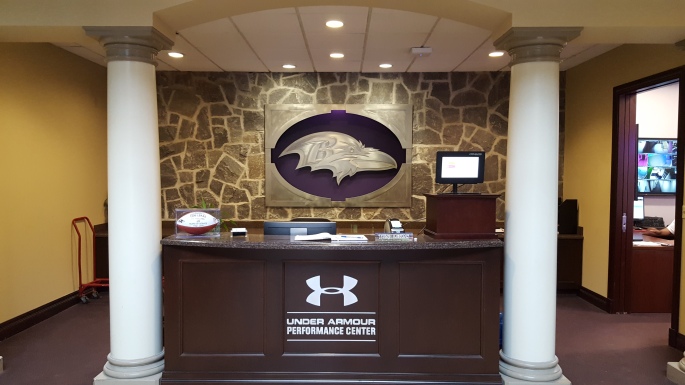
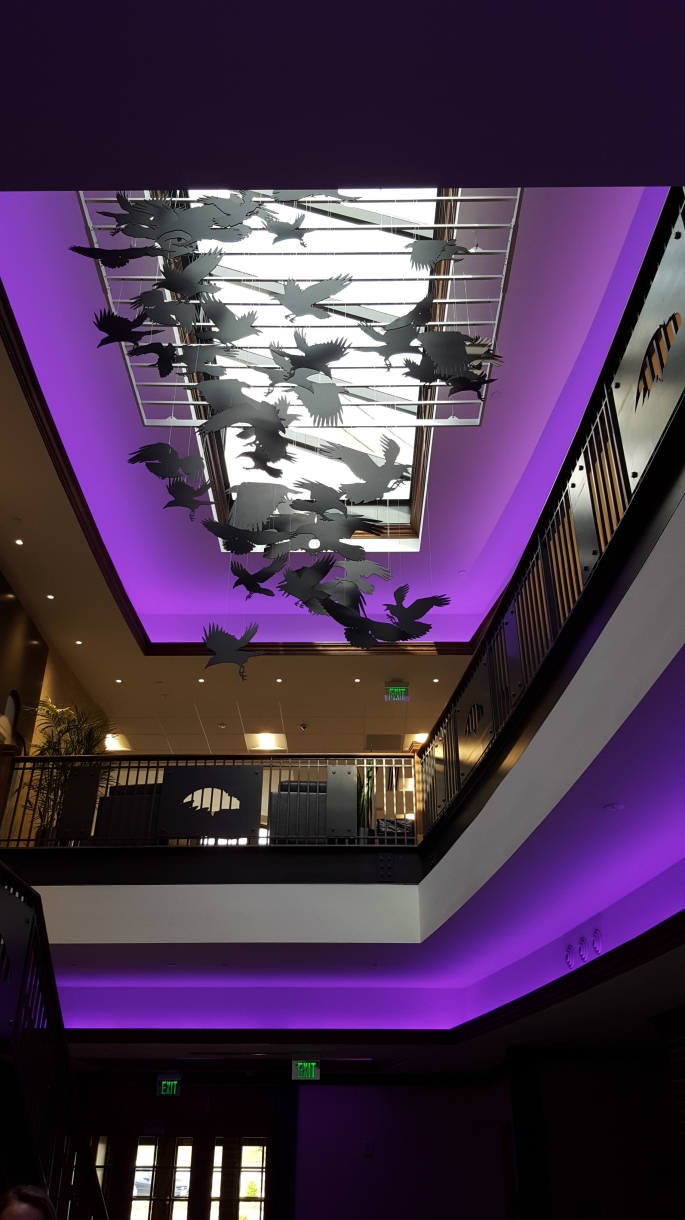
Erin took us to many places.
> We went to The Meeting Theatre.
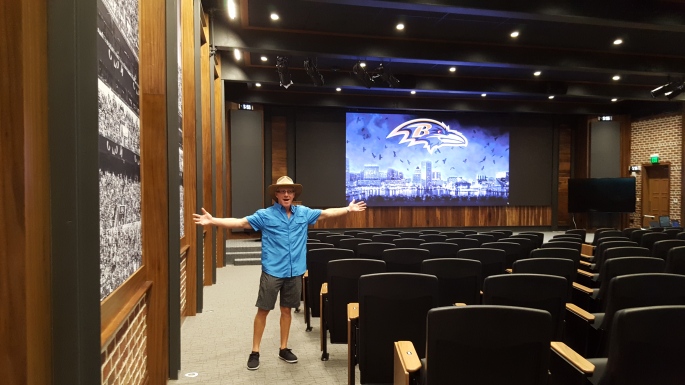
> We went to an Audio/Visual Control Room.
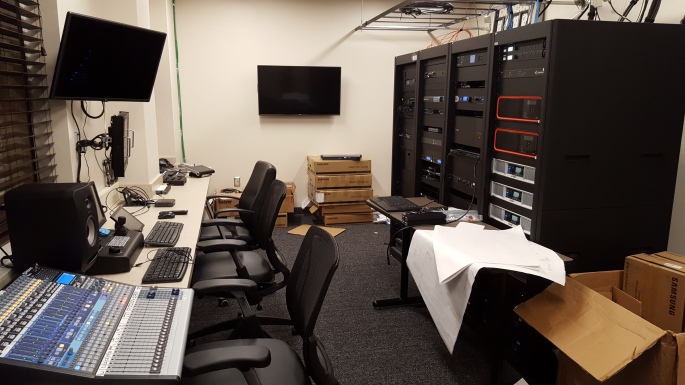
> We went to an area where the Audio/Visual Team does interviews.

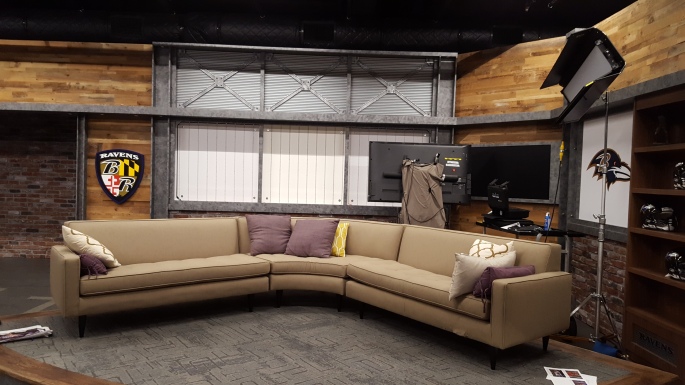

> We went to the beautiful Cafeteria.
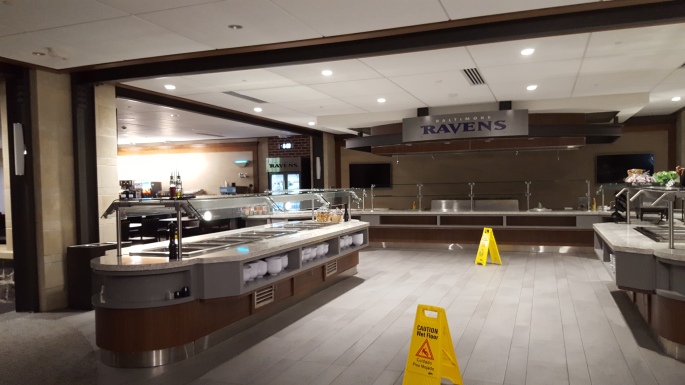
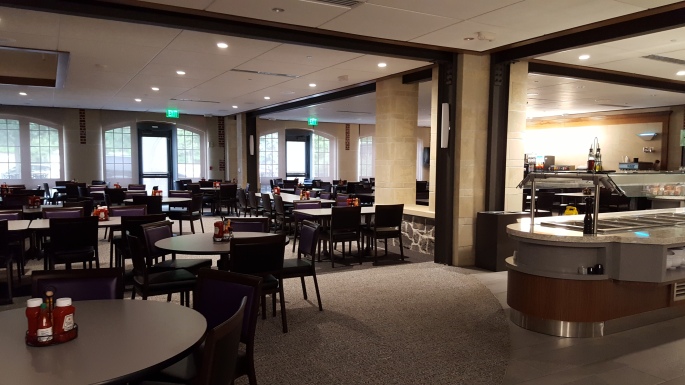

> We went to many other areas, but photos were not allowed. It was a great experience that not many folks get to do.
We are grateful to Erin & The Ravens Security Staff who allowed us access.
Erin also gave us a ride back to the marina.
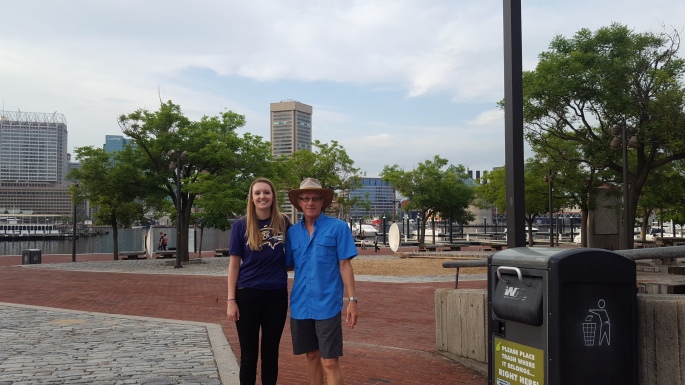
On the ride back, we learned that Erin lived just south of the marina, so she was very familiar with the area.
Erin recommended a Tiki Bar on the water, and said that one of her favorite restaurants, Little Havana, was very close to the marina.
We walked to The Tiki Bar – it looked like a very cool place, but rain clouds were gettin’ dark again, radar showed a big storm coming, so we passed on the outdoor Tiki Bar for now.

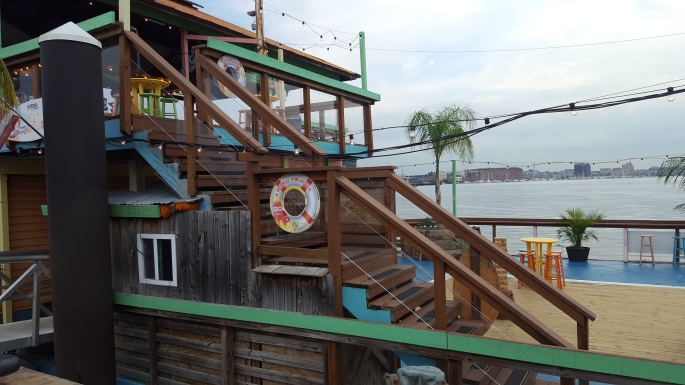

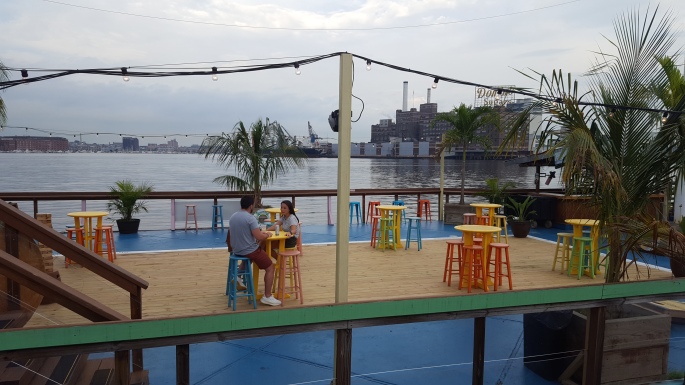
About 5 minutes away from the Tiki Bar, we arrived to the dry safety at Little Havana.
The ambiance was cool, and the food was good.
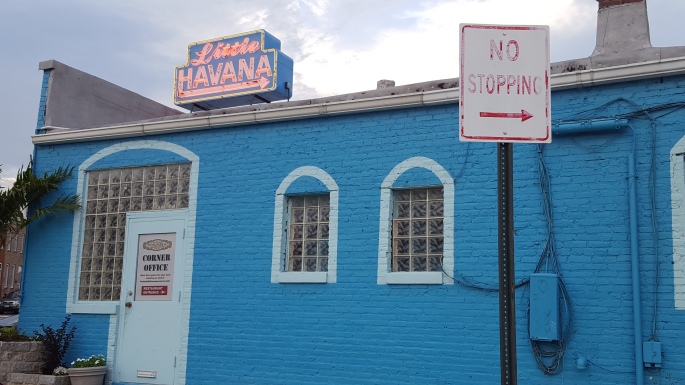
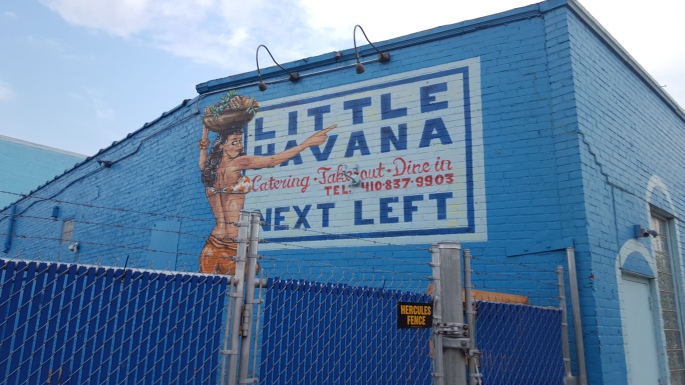
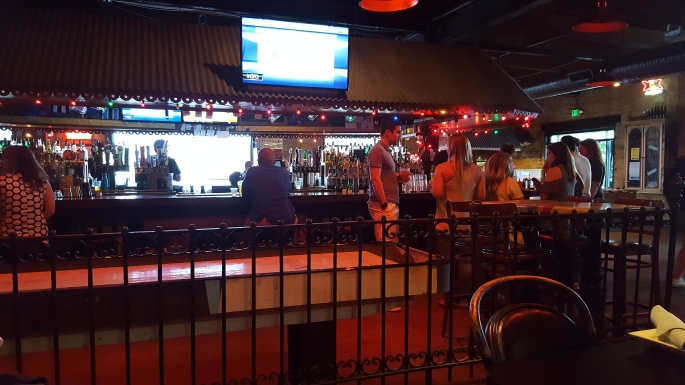
Jun 21 – Thu
After the very fun Sports Day on Wednesday, Thursday was Patriotic History Day.
We started the day at The Baltimore World Trade Center.
We did not know it, but there is a World Trade Center at every Port City in the World.
there are over 90 centers in the USA and over 200 in the world.
The Baltimore World Trade Center had several sites honoring The New York World Trade Centers.

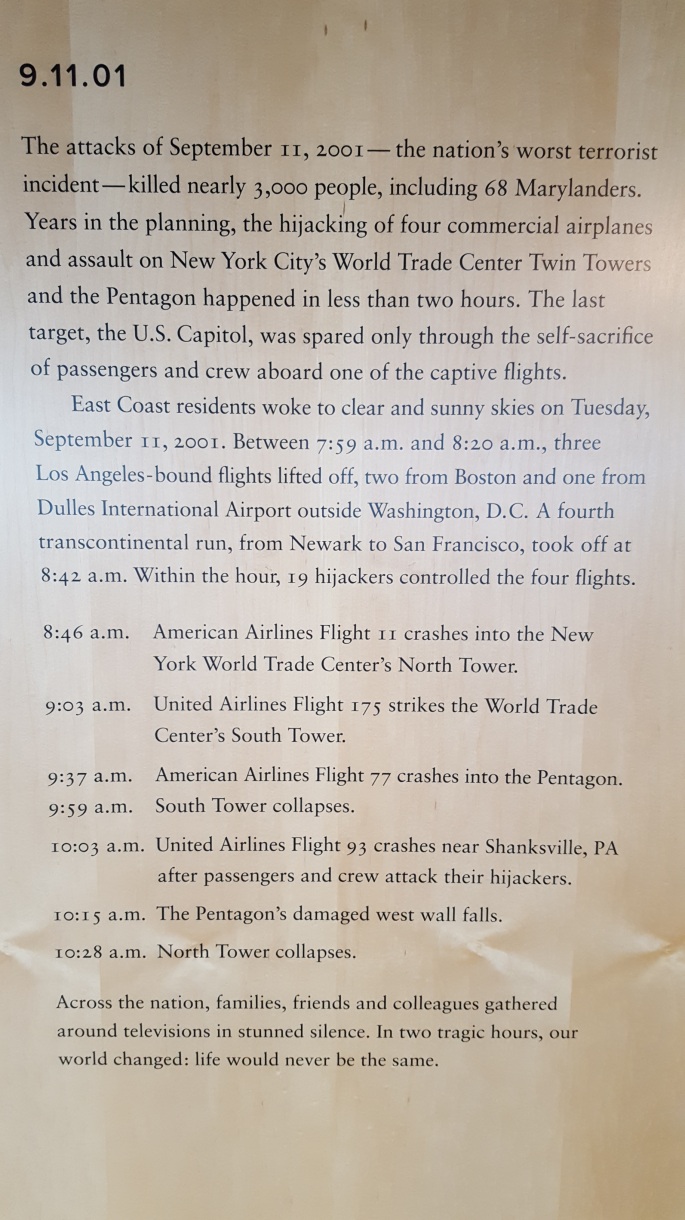
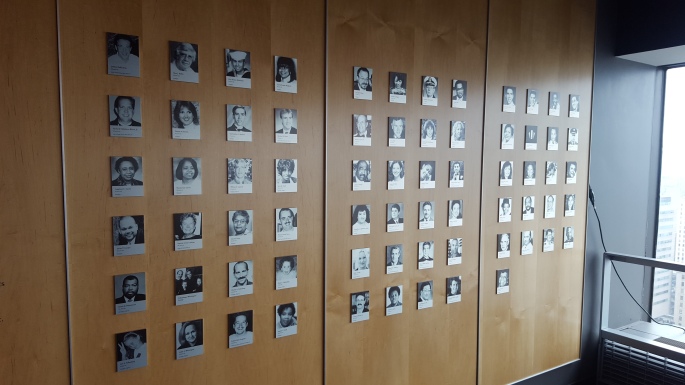
The views at the top were as expected, incredible, similar to our experience at the Sears tower (Willis Tower) in Chicago. We can’t wait to get to New York.

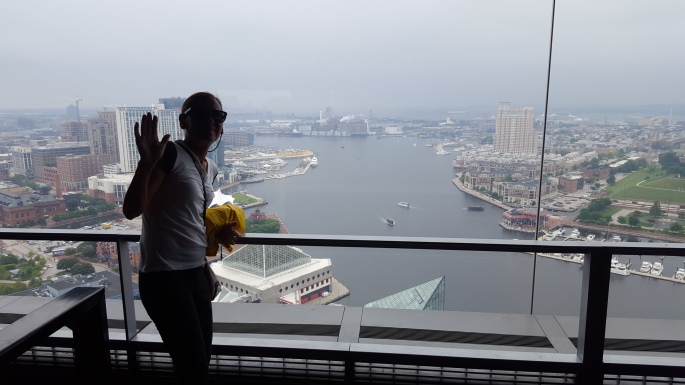

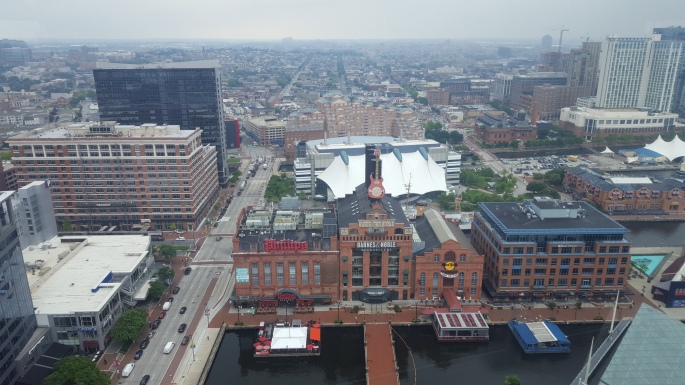
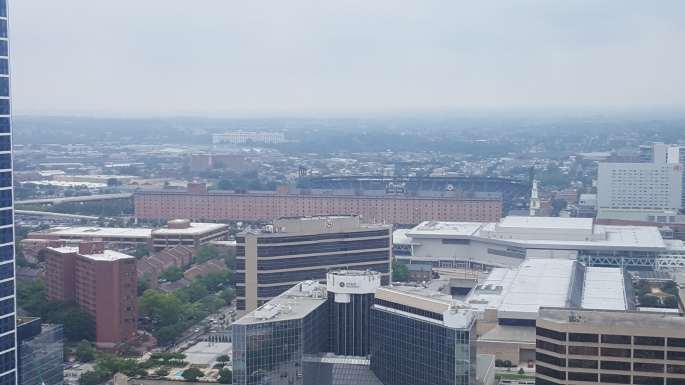

> You could also see some of the historic museum boats for walk thru tours

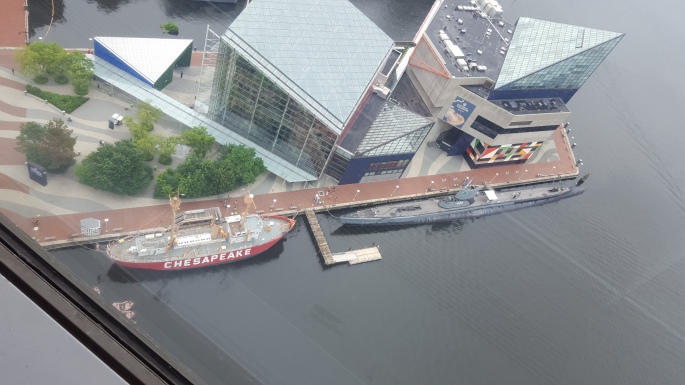
Next Stop on the history tour was The Star Spangled Banner Flag House.
You may ask – what is this house ?
Well, let me tell you !
The Star Spangled Banner House, is the house where the flag was sewn which prompted Francis Scott Key to write our current National Anthem (originally a poem entitled ” The Defence of Fort McHenry”).
Timeline – Sequence of Events to the creation of The Star Spangled Banner.
> The flag was made in 6 weeks during July-August 1813, by flagmaker Mary Pickersgill.
> This is the building where the flag was sewn.

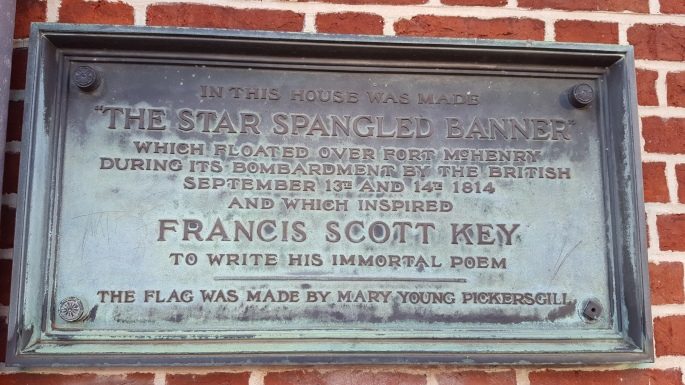
> Two flags were commissioned by Major George Armistead, commander of Fort McHenry during the War of 1812, when the British were attempting to reclaim The American Colonies.
> There was a smaller “Storm Flag” for inclement weather & a larger Grand Garrison Flag to be raised on a 90 foot flag pole for special occasions.
> The size of the Fort McHenry Garrison Flag was 30 feet by 42 feet.
> The flag has fifteen stars and fifteen stripes.
> Each star is about two feet in diameter, each stripe about 24 inches wide.
> Todays modern military garrison flags measure a standard 20 x 38 feet.
> The first Flag Act of June 14, 1777, created the original United States flag of thirteen stars and thirteen stripes. The Star-Spangled Banner has fifteen stars and fifteen stripes as provided for in the second Flag Act approved by Congress on January 13, 1794. The additional stars and stripes represent Vermont (1791) and Kentucky (1792) joining the Union
> In August of 1814 The British attacked and captured Washington DC and burned most of the buildings related to the American Independence (including the White House).
> Baltimore & Fort McHenry, only 30 miles away from Washington, prepped for attack, & the flag was made for Fort McHenry in preparation of this battle.
> The British arrived at Baltimore in September 1814.
> At 6:30 AM on September 13, 1814, the British began a 25-hour bombardment of the Fort McHenry. Rockets whistled through the air and burst into flame wherever they struck. Mortars fired 10 and 13 inch bombshells that exploded overhead in showers of fiery shrapnel. Major Armistead, commander of Fort McHenry and its defending force of one thousand troops, ordered his men to return fire, but their guns couldn’t initially reach the enemy’s ships. When British ships advanced on the afternoon of the 13th, however, American gunners badly damaged them, forcing them to pull back out of range. All through the night, Armistead’s men continued to hold the fort, refusing to surrender. That night, the additional British attacks also failed, and by dawn they had given up hope of taking the city.
> As dawn arrived and the smoke cleared above Fort McHenry on the morning of September 14, 1814, The Grand Garrison Flag was raised, signaling American victory over the British in the Battle of Baltimore; the sight inspired Francis Scott Key to write a poem entitled – The Defence of Fort McHenry, which led to the “The Star-Spangled Banner”.
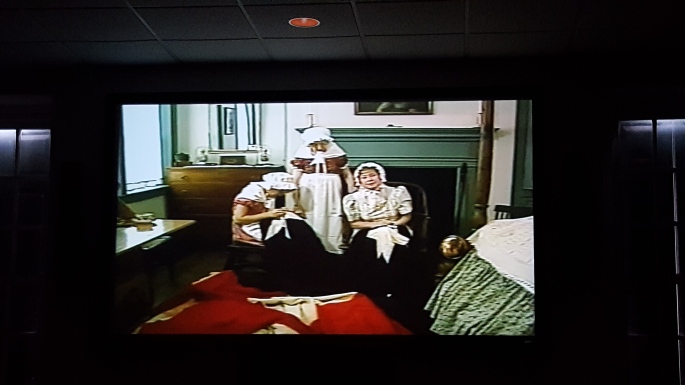
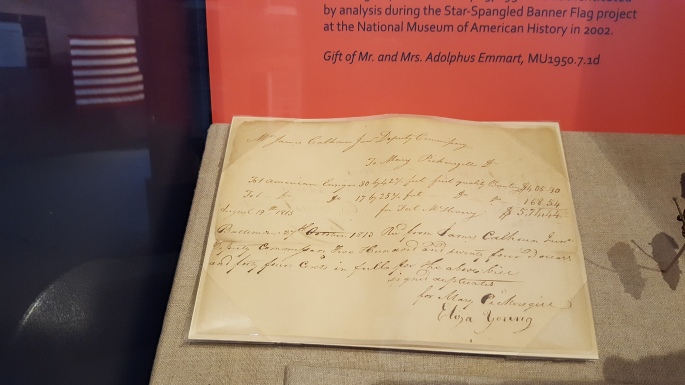
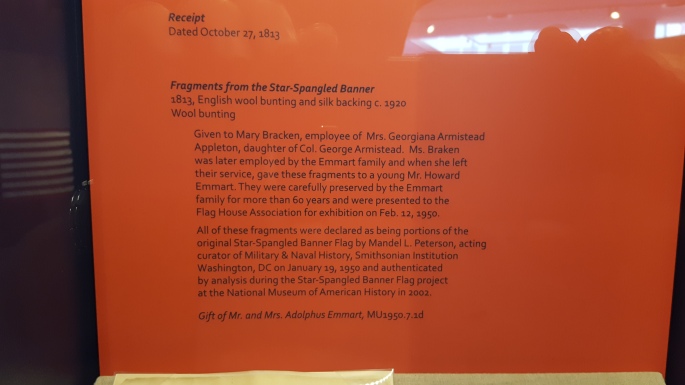
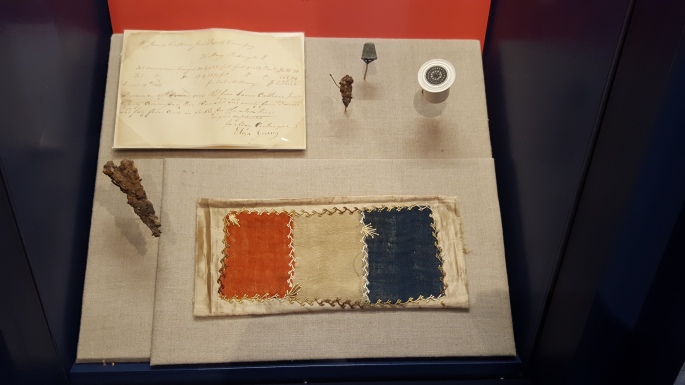
Ok, now on to Francis Scott Key
> Before departing Washington after setting it on fire, the British soldiers had arrested a man named Dr. William Beanes. They imprisoned him on a British warship headed to Baltimore.
> Friends of Dr. Beanes asked Georgetown lawyer Francis Scott Key & US Government agent John S. Skinner, to help secure the release of the civilian prisoner. Francis Scott Key & Skinner were successful in his release; however, the British feared that Key and Skinner would divulge their plans for attacking Baltimore, and so they detained the two men aboard a truce ship for the duration of the battle. Thus Francis Scott Key became an eyewitness to the bombardment of Fort McHenry from a British Ship.
> When he saw the American flag soaring above the fort the morning of September 14, 1814, , Key knew that Fort McHenry had not surrendered. Moved by the sight, he began to compose a poem on the back of a letter he was carrying. On September 16, Key and his companions were taken back to Baltimore and released.
> The next day he showed the poem to his wife’s brother-in-law, Judge Joseph Nicholson, who had commanded a volunteer company at Fort McHenry. Nicholson responded enthusiastically and urged Key to have the poem printed. First titled “The Defence of Fort McHenry,” the published poem included instructions that it be sung to the 18th-century British melody “Anacreon in Heaven” — a tune Key had in mind when he penned his poem. Copies of the song were distributed to every man at the fort and around Baltimore. The first documented public performance of the words and music together took place at the Holliday Street Theatre in Baltimore on October 19, 1814. A music store subsequently published the words and music under the title “The Star-Spangled Banner.
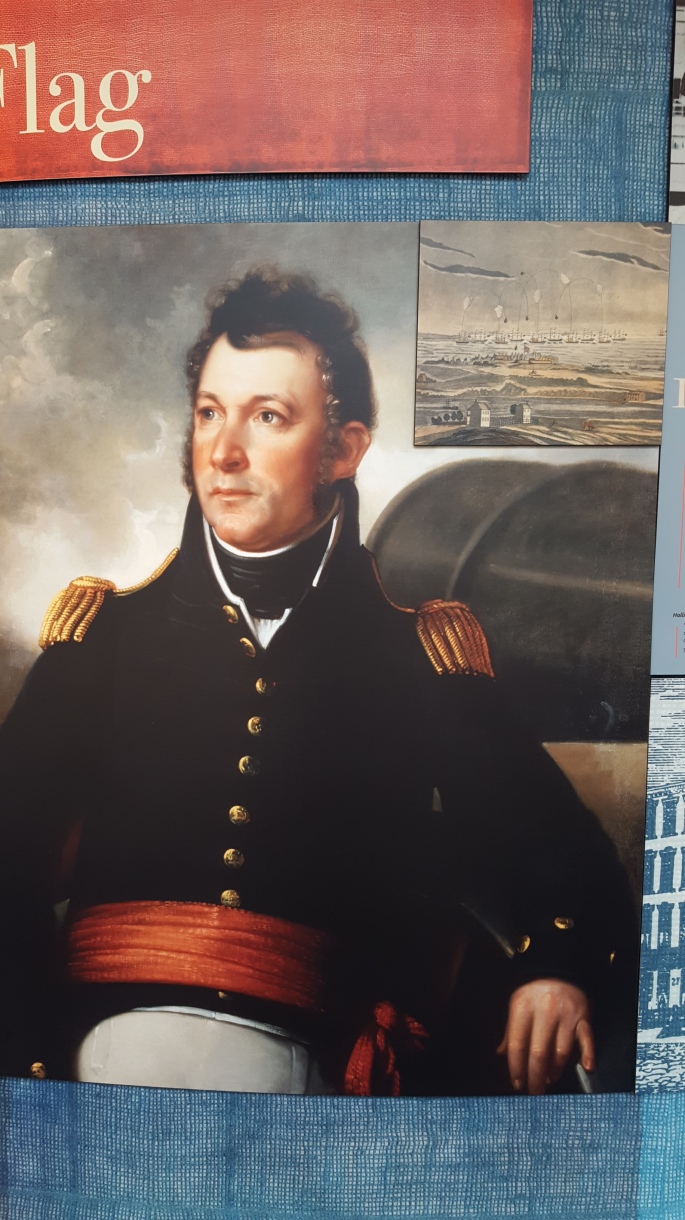

More about The Fort McHenry Flag
> Since the famed battle , the flag was preserved by the Armistead family for years as a memento of the battle.
> First loaned to the Smithsonian Institution in 1907; converted to permanent gift in 1912.
> It is currently on exhibit at the National Museum of American History in Washington DC since 1964 (oops, we did not go to the museum while in DC, turn the boat around).
> A major, multi-year conservation effort to save the delicate flag was launched in 1998.
> Plans for new permanent exhibition gallery are now underway at the Smithsonian.

That’s all for the Flag, Francis Scott Key, and The Star Spangled Banner.
Next stop was the B&O Railroad Museum.
The B&O Railroad Quick History (I promise quicker than the Star Spangled Banner)
> America’s 1st railroad, opened in 1830.
> Prompted by the desire to connect the thriving city of Baltimore to the newly opened Erie Canal system (1820) & the commerce of the Great Lakes.
> Chartered in 1827 by a group of Baltimore businessmen, construction began in 1828, and opened in May, 1830.
> The museum is located in the old B&O Mount Clare Station built in 1829, the oldest railroad complex in the United States.
The museum has a very large circular building called The Roundhouse.
The Roundhouse has about 22 railroad tracks entering into a circular pivot table, and was used as a repair station for lighter passenger car train cabins. The Roundhouse is now used to tell a chronological story about the evolution of the railroad, steam engines, cabin cars, & contribution of the railroad to the civil war & technology.

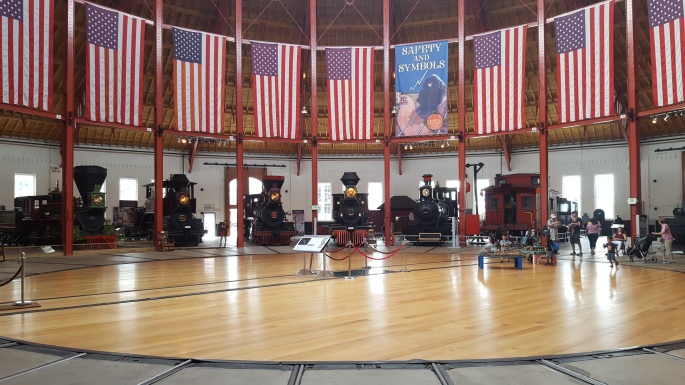

> B&O tour guide Bob led us through a little historical timeline as we walked thru the evolution of the Railroad System & the Steam Powered Locomotive.
> Horses were the first source of power, but the successful trial run of Peter Cooper’s Tom Thumb Locomotive in Aug, 1830, brought the change from horses to the steam locomotives.
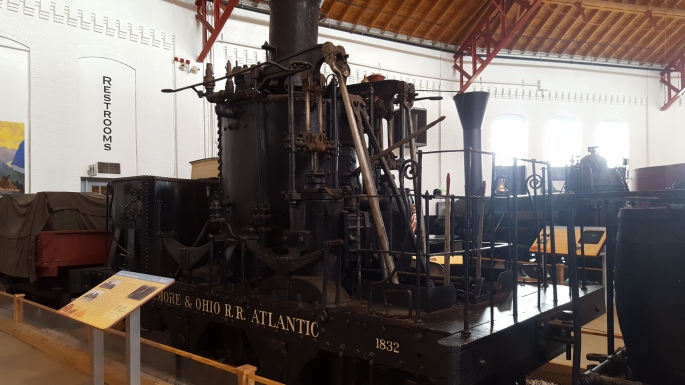
> The next evolution was a more efficient horizontal steam tank & power linkage

> Bob explained how the railroad system also contributed to civil engineering feats like the 1st major railroad viaduct, The Carrollton Viaduct on the outskirts of Baltimore.

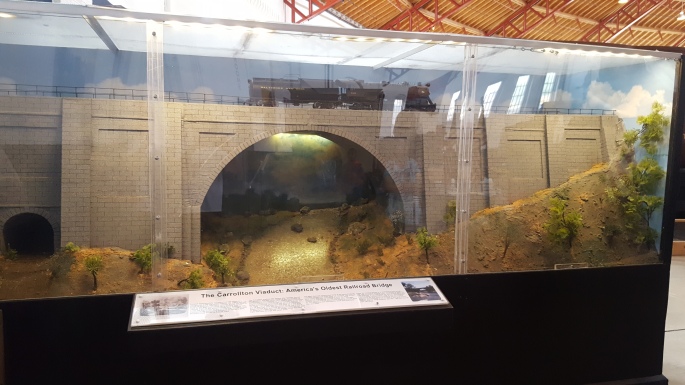
> The evolution of the train cars – in previous coal cars the coal had to be loaded & unloaded by shovel. Then came the Hopper car, which could unload via the drop door under the hopper.
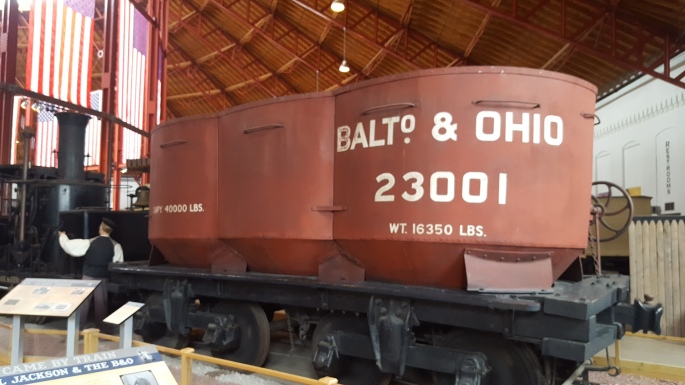
> Bob spoke of the Civil War, and how the B&O Railroad belonged to the Union, and the Confederates thought that if they could disable the RR that they could win the war. The owner of the B&O Railroad was friends with President Lincoln, and asked Lincoln for protection. There was actually a division of the Union Army that was responsible for protecting the railroad.
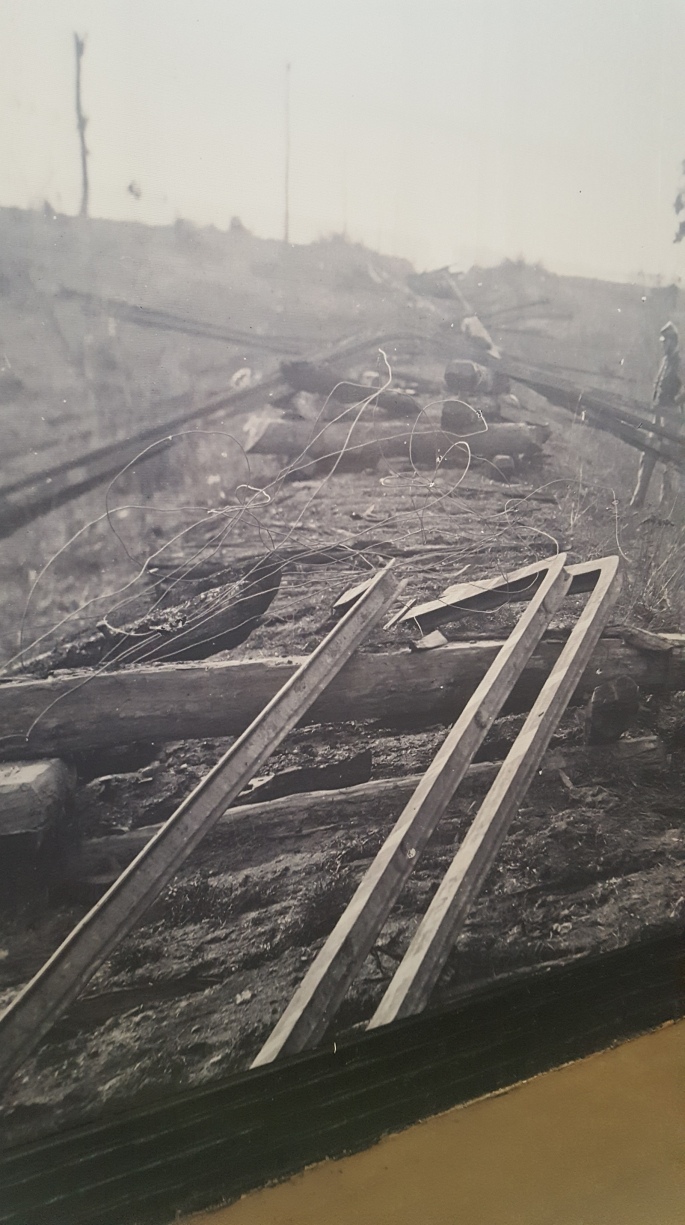
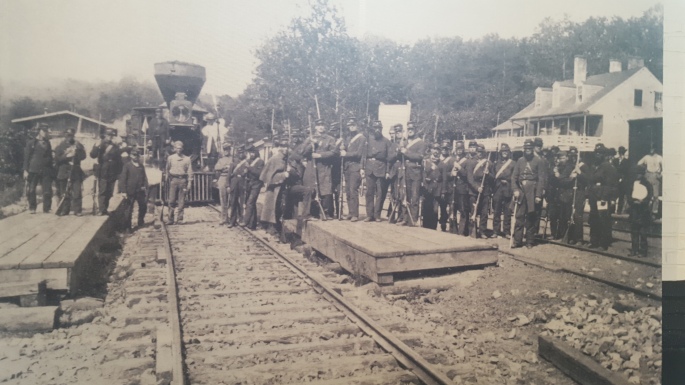
> After the Civil War, Bob led us thru the design of the Steam Locomotive as it evolved thru WWI – Standardization of the RR Systems & Cars between all producers, communication improvements between conductor & brakemen, improved safety, improved ability to climb grades.
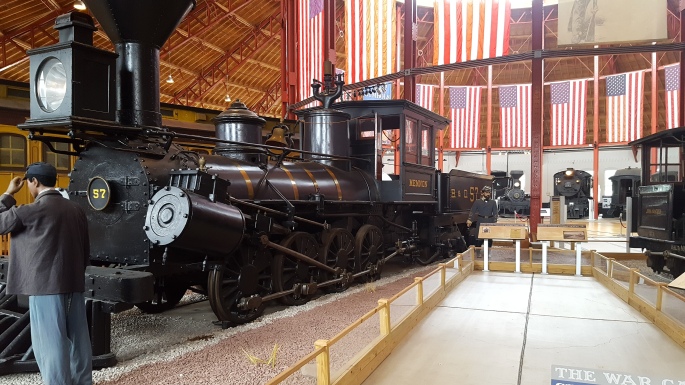

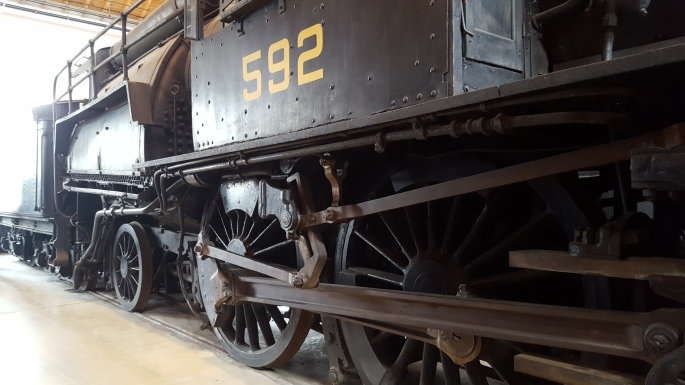


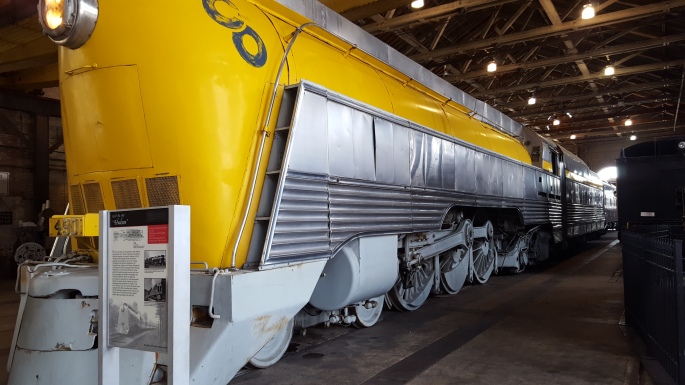
> For much of its history, the B&O had been collecting locomotives and other artifacts from its history for public relations purposes. This collection was stored in various places, until the railroad decided to centralize it in a permanent home. The Mt. Clare location was chosen, and the new museum opened on July 4, 1953.
> The museum ended up outliving the B&O Railroad, and was kept intact by both the Chessie System and CSX Corporations. In 1990, CSX deeded the property & collection of trains to the newly formed museum and provided it with a $5 million endowment. In 1999 the museum became affiliated with the Smithsonian Institution.
> BTW – The B&O stands for Baltimore & Ohio, the end points of the initial railroad !
Well, that’s it from Baltimore.
It was really a very cool city, and much more interesting than I expected.
Next Stops ;
> Chesapeake City Maryland – 2 days
> Cape May New Jersey – 2 days
> Atlantic City New Jersey – 2 days
> Manasquan New Jersey – 1 day
> New York City – 4 days

Murph – Nice job with the Baltimore Blog. I experienced many of the same things during days/nights supporting the FCA Port of Baltimore. Very Cool City. Funny part is I too ended up in the wrong ‘spot’ on my first venture to Fells Point!! Safe Travels.
LikeLike
Thx Pauli,
Nice to hear from you
Thx for following the blog
LikeLike
Delayed reading this blog due to time constraints. As usual, an outstanding job of providing history and local good stuff. Great job Mike.
LikeLike
Thanks again Commander
Joe
LikeLike
Holy blog post Batman!! Great job Mike. I basically knew nothing of Baltimore prior to reading this, but will definitely make a point to visit when I finally get to do the loop.
LikeLike
Your welcome Buck
When you get ready to take off, if we can answer any questions, give a call
Mike & Jonell
586 202 6295
LikeLike